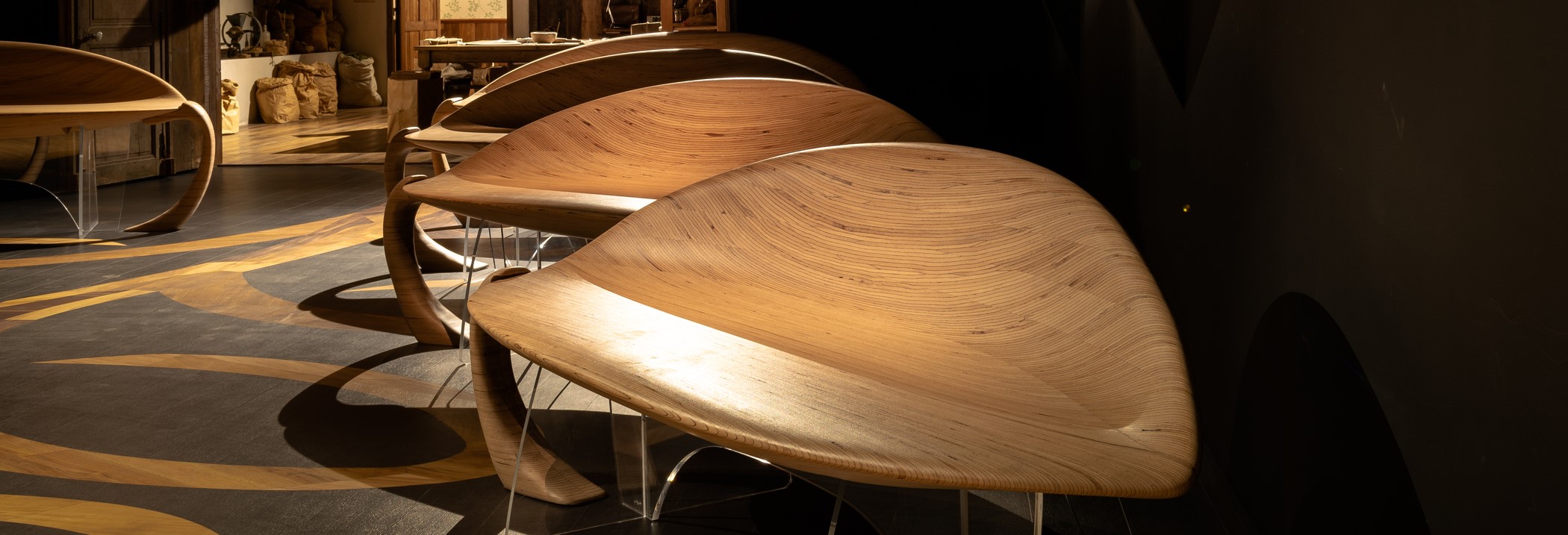
The small town of La Gacilly in Brittany, France, is the home of the Yves Rocher natural cosmetic brand, and the company’s headquarters are still located here. On 30 September 2017, Maison Yves Rocher was opened in La Gacilly. At this unique, multi-sensory museum, visitors are brought on a scenic journey through the life and vision of the company founder Yves Rocher. For two of the five striking rooms of Maison Yves Rocher, BauBuche has been chosen as the dominating material.
La Prod est dans le Pré, La Rochelle, F
Séquoia, Epône, F
September 2017
Pollmeier, D-99831 Amt Creuzburg
Séquoia, Yves Rocher
In the autumn 2017, Maison Yves Rocher, a unique visitor attraction opened its doors in the small town of La Gacilly in Brittany (France). La Gacilly is the birthplace of the founder of the renowned French natural cosmetics line Yves Rocher. In the late 1950s, Yves Rocher retired to the attic of his parents’ house to experiment with various ingredients, coming up with beauty products based entirely on plants. In 1959, he launched the Yves Rocher brand and never looked back. Today, the site houses the Yves Roche Institute, a shop and a restaurant. The latest addition to the complex is the Maison Yves Rocher located in a restored mill. The five rooms of the museum unveil the world of the Yves Rocher brand in an immersive journey full of sensory experiences with video projections, theatre and audio playback. This unique project was developed under the auspices of the multimedia specialists of “La Prod est dans le Pré”, an agency based in La Rochelle.
The first room is dedicated to the life of Yves Rocher and his vision. In the second room, visitors are introduced to the ingenious world of plants. The virtual tour guide then invites visitors to continue to the third room to find out how active botanical ingredients are used in cosmetics. The fourth room is a reconstruction of the attic were it all began, bringing visitors back in time to the 1950s. The fifth room is dedicated to the winners of the Women of the Earth Award of the Yves Rocher Foundation, honouring women who have shown extraordinary commitment to the protection of the environment. As visitors enter the museum, they become immersed in a surreal environment that speaks to all their senses.
For two of the five exhibition rooms, the project managers of “La Prod est dans le Pré” chose BauBuche as the primary internal design material. The floral design of the furniture in room 5 mimics for instance a branch with leaves, as the floor projection reveals: there are eight benches in the shape of leaves aligned in two rows along a centre aisle. The leaf-shaped benches measure just under 2.20 m in width. The seating area and the backrest form one leaf, folded along the midrib.
Their ends taper out, similar to leaf tips. All edges are rounded and the various surfaces follow smooth, seamless lines.
During their search for a material for these organically shaped benches and associated objects, the museum designers came across BauBuche. They instantly realised that this hardwood material was ideally suited for the task. They opted for 30 mm and 60 mm panels that were individually cut to size, and then glued together in stacks, resembling elevation models. The stepped edges of the objects were then milled, sanded and polished to obtain organic shapes. As BauBuche is extremely strong and durable, the material could be milled with high precision. There is no fraying at the edges, and the glued lines between the lumber layers give the finished objects an attractive geometrical pattern that resembles wood grain. Depending on the milled angle, the grain lines are close together or further apart from each other, a feature that pleased the designers in particular. The decision for BauBuche was also made easy by the fact that the price for the material was well within the project budget.
The model of a hilly landscape with a tree in room 2 was also constructed in BauBuche and with the same method or gluing, milling and sanding, although the objects here are much larger in size. The stepped levels feature both smooth finishes and surfaces with milled grooves that add a dynamic to the abstract landscape represented by the objects. The visual impact of the groove pattern varies depending on the viewpoint of the visitor. The ensemble with its seamless, organically shaped surfaces and attractive haptics invites visitors to sit down, reflect and relax. It took the agency two and a half year to finish this very special museum, which is well worth a visit. The immersive walk through Maison Yves Rocher take about 45 minutes.
-Text by Susanne Jacob-Freitag –
Advice for architects, building engineers, clients and timber construction companies